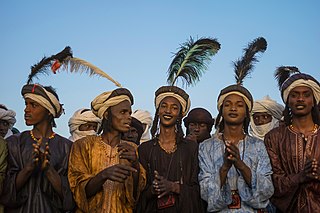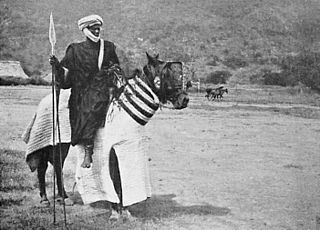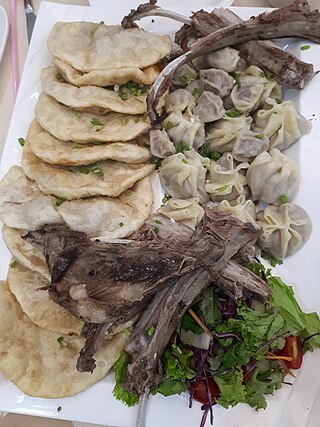This article needs additional citations for verification .(July 2007) |
Awlad Mana is an ethnic group of Sudan. It is a minority, that speaks Zaghawa, a Chad-Saharan language. They number more than 150,000 people.
This article needs additional citations for verification .(July 2007) |
Awlad Mana is an ethnic group of Sudan. It is a minority, that speaks Zaghawa, a Chad-Saharan language. They number more than 150,000 people.
A Cluster of 4 Zaghawa Groups in 2 countries; The Zaghawa (who refer to themselves as the Beri), are scattered throughout central Africa in the countries of Chad and Sudan. All of the groups, including the Awlad Mana, speak Zaghawa (sometimes called Beri), which belongs to the Saharan branch of the Nilo-Saharan language family.
The Zaghawa inhabit a territory that consists mainly of grassy stretches and plateaus with deep gullies; desert surrounds them to the North, East, and West. Rainfall, though sometimes inadequate, provides the Zaghawa with fairly dense vegetation, since the water can seep quickly into the sandy soil. However, during the dry months, lack of water can become a problem. The tsetse fly, which causes sleeping sickness, can also be found in the southern regions.
The Zaghawa are an ancient society dating back to the 7th century. Long ago, they had their own kingdom that was separated into chiefdoms, castes (strict social classes), and family clans. The remnants of this ancient kingdom can still be seen today.
Since the independence of Sudan and Chad, the governments have greatly reduced the power of the Zaghawa chiefs. Also, Islam has weakened their traditional clan system. Today, the Zaghawa are concerned about their economic welfare, their political independence, and their national heritage. Their economy is based on animal husbandry, agriculture, gathering, and trading. Cattle, sheep, camels, and other animals are raised and marketed, primarily for their milk. The milk of cattle, sheep, and camels is consumed either hot or cold, sour or fresh, pure or mixed with water or tea, as a porridge mixed with millet, or as butter. The milk of a donkey may also by drunk as a remedy for coughing. Animal skins are used to make clothing and leather items, and the meat is eaten as a part of their diet.
Tubers (starchy root vegetables) and millet are grown in the fields, while vegetables such as onions, tomatoes, and okra are grown in small gardens surrounding the homes. The women are responsible for cultivating these small vegetable gardens. They also gather wild grasses, seeds, berries, and other fruits. Small groups of women set out for journeys that last about a month, taking with them all that is necessary for their gathering expedition. They sleep under shelters built from branches and bundles of grass. After the gathering is complete, the various grains are stored in earthen jars, for cereals are not mixed within the same granary. In addition to the products gathered by the women, the Zaghawa may also gather honey, certain leaves, and locusts for consumption.
Many Zaghawa are merchants, traveling southward and eastward to find food supplements and manufactured goods that they lack in their own region. Cattle, sheep, wild grasses, and the gum of the Acacia Senegal are exchanged for sugar, tea, oil, blankets, dried dates, soap, and aspirin.
Some of the Zaghawa work as blacksmiths (as these craftsmen are collectively called). Their craft involves making metal tools, weapons, and jewelry; making pottery; and carving wooden stools and musical instruments. A few of the blacksmiths also tan hides, make various leather items, weave cotton, and hunt. In times past, the blacksmiths depended primarily on hunting for survival. However, since the introduction of firearms in the area, there is a limited amount of game in the region. Among the Zaghawa, blacksmiths are considered to be the lowest caste.
Most Zaghawa villages contain Islamic mosques, which are used for prayer. There is also a "men's tree," where the men gather to discuss the affairs of the village. Inside the villages, young girls may be seen grinding grain and making porridge, while the young boys help with the herds or the harvest. From the time a child is very young, he is taught the way of life that his caste will offer them.
Since the introduction of Islam to the region in the 17th century, most of the Zaghawa have gradually converted to Islam. However, some continue to practice their ethnic religion. They are very superstitious and have a strong belief in the "evil eye." This is a curse caused by an intent gaze of an envious person. To avoid such curses, babies' faces are covered in public, charms are worn, and even houses are constructed in a certain fashion.

Porridge is a food made by heating or boiling ground, crushed or chopped starchy plants, typically grain, in milk or water. It is often cooked or served with added flavourings such as sugar, honey, fruit, or syrup to make a sweet cereal, or it can be mixed with spices, meat, or vegetables to make a savoury dish. It is usually served hot in a bowl, depending on its consistency. Oat porridge, or oatmeal, is one of the most common types of porridge. Gruel is a thinner version of porridge and congee is a savoury variation of porridge of Asian origin.

The Fula, Fulani, or Fulɓe people is an ethnic group in Sahara, Sahel and West Africa, widely dispersed across the region. Inhabiting many countries, they live mainly in West Africa and northern parts of Central Africa, South Sudan, Darfur, and regions near the Red Sea coast in Sudan. The approximate number of Fula people is unknown, due to clashing definitions regarding Fula ethnicity. Various estimates put the figure between 25 and 30 million people worldwide.

The Tuareg people are a large Berber ethnic group that principally inhabit the Sahara in a vast area stretching from far southwestern Libya to southern Algeria, Niger, Mali, and Burkina Faso. Traditionally nomadic pastoralists, small groups of Tuareg are also found in northern Nigeria.

The Baggāra or Chadian Arabs are a nomadic confederation of people of mixed Arab and Arabized indigenous African ancestry, inhabiting a portion of the Sahel mainly between Lake Chad and the Nile river near south Kordofan, numbering over six million. They are known as Baggara and Abbala in Sudan, and as Shuwa Arabs in Cameroon, Nigeria and Western Chad. The term Shuwa is said to be of Kanuri origin.
The Fur are an ethnic group predominantly inhabiting western Sudan. They are concentrated in the Darfur region, where they are the largest ethnic group. They speak the Fur language, which belongs to the Nilo-Saharan family.

The Nuer people are a Nilotic ethnic group concentrated in the Greater Upper Nile region of South Sudan. They also live in the Ethiopian region of Gambella. The Nuer speak the Nuer language, which belongs to the Nilotic language family. They are the second largest ethnic group in South Sudan. The Nuer people are pastoralists who herd cattle for a living. Their cattle serve as companions and define their lifestyle. The Nuer call themselves "Naath".
The Zaghawa people, also called Beri or Zakhawa, are a Sahelian ethnic group primarily residing in southwestern Libya, northeastern Chad, and western Sudan, including Darfur.
African cuisine is a staple of the continent's culture, and its history is entwined with the story of the native people of Africa. The foods that native Africans eat have been influenced by their religions, as well as by their climates and lifestyles. The first Africans to inhabit the continent were hunter-gatherers who ate what they could find in nature. As agriculture became more common in Africa, so did agriculture-based diets.

The Toubou or Tubu are an ethnic group native to the Tibesti Mountains that inhabit the central Sahara in northern Chad, southern Libya and northeastern Niger. They live either as herders and nomads or as farmers near oases. Their society is clan-based, with each clan having certain oases, pastures and wells.

The Ennedi Plateau is located in the northeast of Chad, in the regions of Ennedi-Ouest and Ennedi-Est. It is considered a part of the group of mountains known as the Ennedi Massif found in Chad, which is one of the nine countries that make up the Sahelian belt that spans the Atlantic Ocean to Sudan. The Ennedi is a sandstone bulwark in the middle of the Sahara, which was formed by erosion from wind and temperature. Many people occupied this area, such as hunters-gatherers and pastoralists. The Ennedi area is also known for its large collection of rock art depicting mainly cattle, as these animals had the greatest financial, environmental, and cultural impact. This art dates back nearly 7,000 years ago. Today, two semi-nomadic groups, mainly Muslim, live in the Ennedi during the rainy months and pass through the area during the dry season. They rely on their herds of camels, donkeys, sheep, and goats to survive.
The Kara are an ethnic group inhabiting South Sudan and the Central African Republic. They speak the Gula language, and Nilo-Saharan, which is a Central Sudanic language.
Tama are a non-Arab, African ethnic group of people who live in eastern Chad and western Sudan. They speak Tama, a Nilo-Saharan language. The population is 200,000–300,000 people and they practice Islam. Many Tama are subsistence farmers who live in permanent settlements and some raise livestock. In the civil war in Chad (2005–2010) the Tama were involved in ethnic conflicts with the Zaghawa tribe.

Mongolian cuisine predominantly consists of dairy products, meat, and animal fats. The most common rural dish is cooked mutton. In the city, steamed dumplings filled with meat—"buuz"— are popular.
Caste systems in Africa are a form of social stratification found in numerous ethnic groups, found in over fifteen countries, particularly in the Sahel, West Africa, and North Africa. These caste systems feature endogamy, hierarchical status, inherited occupation, membership by birth, pollution concepts and restraints on commensality.

Nepali cuisine comprises a variety of cuisines based upon ethnicity, alluvial soil and climate relating to cultural diversity and geography of Nepal and neighboring regions of Sikkim and Gorkhaland. Dal-bhat-tarkari is eaten throughout Nepal. Dal is a soup made of lentils and spices, bhat — usually rice but sometimes another grain — and a vegetable curry, tarkari. Condiments are usually small amounts of spicy pickle which can be fresh or fermented, mainly of dried mustard greens and radish and of which there are many varieties. Other accompaniments may be sliced lemon (nibuwa) or lime (kagati) with fresh green chilli and a fried papad and also Islamic food items like rice pudding, sewai, biryani etc. Dhindo (ढिंडो) is a traditional food of Nepal. A typical example of Nepali cuisine is the Chaurasi Byanjan set where bhat (rice) is served in a giant leaf platter (patravali) along with 84 different Nepali dishes each served on small plates. It is mostly fed during weddings and Pasni(rice feeding ceremony).

The Hausa are a native ethnic group in West Africa. They speak the Hausa language, which is the second most spoken language after Arabic in the Afro-Asiatic language family. The Hausa are a culturally homogeneous people based primarily in the Sahelian and the sparse savanna areas of southern Niger and northern Nigeria respectively, numbering around 86.84 million people with significant indigenized populations in Benin, Cameroon, Ivory Coast, Chad, Sudan, Central African Republic, Republic of the Congo, Togo, Ghana, Eritrea, Equatorial Guinea, Gabon, Senegal and the Gambia.
Zaghawa is a Saharan language spoken by the Zaghawa people of east-central Chad and northwestern Sudan (Darfur). The people who speak this language call it Beria, from Beri, the endonym of the Zaghawa people, and a, Zaghawa for "mouth". It has been estimated that there are between 750,000 native Zaghawa speakers, who primarily live in Chad and the Darfur region of Sudan.

In 2020, approximately 80% of Chad's labor force was employed in the agricultural sector. This sector of the economy accounts for 52.3% of the GDP, as of 2017. With the exception of cotton production, some small-scale sugar cane production, and a portion of the peanut crop, Chad's agriculture consists of subsistence food production.

The cuisine of Rwanda is based on local staple foods produced by the traditional subsistence-level agriculture and has historically varied across different areas.
The Dendi are an ethnic group located in Benin, Niger, Nigeria and northern Togo mainly in the plains of the Niger River. They are part of the Songhai people. Derived from the Songhay language, the term "Dendi" translates to "down the river." The community consists of 195,633 people. Among them, only 4,505 live in Nigeria. In Niger they live in around the city of Gaya. Their mother tongue is Dendi.